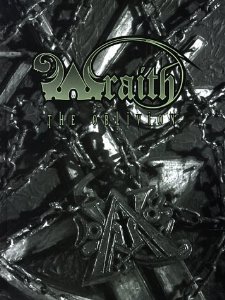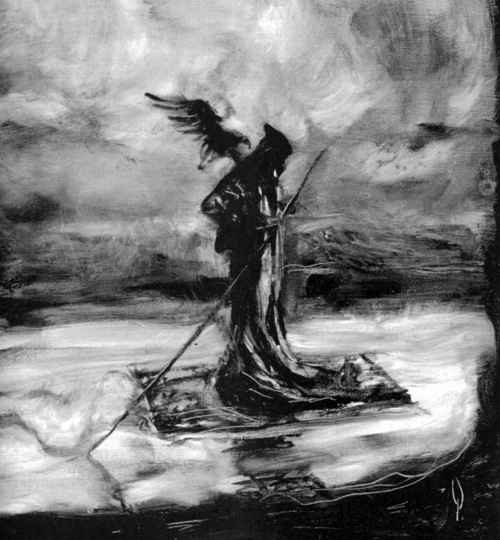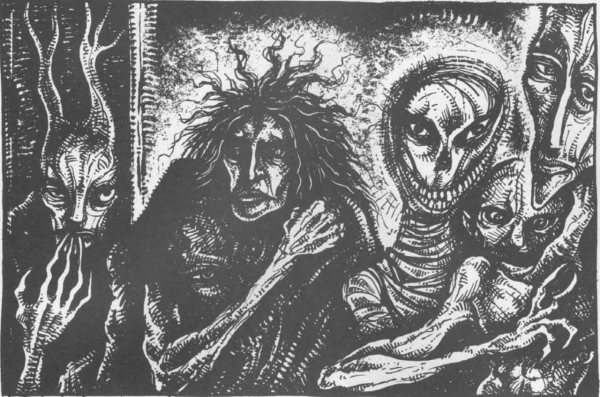You Should Be Playing…
Wraith: The Oblivion
This was not what the afterlife was supposed to be like. If there is a heaven or a hell, it is in a place far from where this is. Death may have come swiftly or slowly, but it still came. And after it was over, something remained. They are bound to the life that can no longer be theirs. The wraiths of the World of Darkness huddle in the shadows, clinging to their passions and fetters. Some wraiths join with the Legions of Stygia, enforcing the laws of their ancient society and following the dictates of a nebulous and ancient bureaucracy. Some wraiths rebel against these laws, seeking a way back to influencing the lives of the living. And still others fall to their own darkness, seeking to drown out everything in the simple, painful expression of Oblivion.
 Wraith: the Oblivion was designed by Mark Rein-Hagen, Jennifer Hartshorn and Sam Chupp in 1994. It was the fourth game in White Wolf Publishing’s original World of Darkness line, and it explored the afterlives of ghosts in their setting. Wraith: the Oblivion was updated for the World of Darkness 2nd Edition in 1996, written by Richard E. Dansky, with its final supplement “End of Empire,” published in 1999. There was a slight rules update in Wraith: the Great War, released earlier in 1999, but the game was never fully updated for the Revised series of the World of Darkness.
Wraith: the Oblivion was designed by Mark Rein-Hagen, Jennifer Hartshorn and Sam Chupp in 1994. It was the fourth game in White Wolf Publishing’s original World of Darkness line, and it explored the afterlives of ghosts in their setting. Wraith: the Oblivion was updated for the World of Darkness 2nd Edition in 1996, written by Richard E. Dansky, with its final supplement “End of Empire,” published in 1999. There was a slight rules update in Wraith: the Great War, released earlier in 1999, but the game was never fully updated for the Revised series of the World of Darkness.
It has had two spiritual successors released by White Wolf, Orpheus and Geist: the Sin Eaters. Wraith: the Oblivion was never a commercially successful game, despite critical praise. Though the game has been out of print for over a decade, copies can still be found on Amazon.com for as low as $30. DrivethruRPG offers electronic copies of the game for $16.99.
The world of Wraith: the Oblivion was at once unrelentingly bleak, and yet filled with bright, poignant points of light. At the heart of Wraith: the Oblivion was a very personal struggle against an all-consuming force of nihilism. The game asked many highly existential questions as part of its creation and featured one of the most open forms of character creation available in the World of Darkness line. At the root of every wraith was the person they had been while they were alive and the regret that had caused them to be unable to find rest in death. While every wraith was unique to their own situation, each shared in the fact that they had died somehow. The afterlife the wraiths had found themselves in was unlike any that had been described through religion or philosophy.
The world of the Shadowlands where Wraith: the Oblivion was set was a one-way, shadowed lens on the world of the living. Wraiths saw the world as a dying, decaying wreck of the real, with the living appearing at once as bright beacons of powerful energy, and shambling bodies dying of a multitude of illnesses. The ghosts of buildings and objects that had held emotional significance could still be found in the Shadowlands, and many were filled with the unintelligent remnants of people who had died without enough regret to transform fully into a wraith.
 Beyond the Shadowlands lay the Tempest, a chaotic tumult of water, storm and land where Stygia held its powerbase. Stygia was the ancient government of the dead, having existed for thousands of years with little change. It marshaled armies of wraiths, separated into Legions based on their cause of death, and set most of the laws and customs in the land of the dead.
Beyond the Shadowlands lay the Tempest, a chaotic tumult of water, storm and land where Stygia held its powerbase. Stygia was the ancient government of the dead, having existed for thousands of years with little change. It marshaled armies of wraiths, separated into Legions based on their cause of death, and set most of the laws and customs in the land of the dead.
Beneath the Tempest could be found the Labyrinth, a twisting series of passageways, devoid of light, where the Spectres – wraiths who had fallen to their own self-destructive impulses and pain – dwelled. The Tempest and the Labyrinth were infinite in expanse, and they held many strange and dangerous things, occasionally erupting into the Shadowlands as the hurricane-like Maelstroms.
Wraith: the Oblivion was truly massive in its scope. With the incorporation of the Tempest and the Labyrinth, there was nearly no limit to the strange and otherworldly things that could be found in the afterlife. The world of Wraith: the Oblivion served as one of the driving dangers of the game, as nowhere was safe from the threat of the Spectres, nor could there ever be any true peace with them. Spectres were connected through a hivemind with each other and with Oblivion itself, actively furthering the destruction of all that exists. To Oblivion, existence was equated with pain. The only way to end all pain was to destroy all there is.
Gameplay
The vast scope of the world in Wraith: the Oblivion contrasted sharply against its ability to focus upon the individual. Wraith: the Oblivion was extremely open in its character creation for a White Wolf system, allowing players to freely choose their character’s allegiances, powers, and specialties. As opposed to its contemporaries, there was no “Splat” mechanic typical of White Wolf’s World of Darkness games, and players were encouraged to create characters with complex and often conflicting allegiances.
The three dominant factions of wraiths were the Hierarchy, Renegades and Heretics. The Hierarchy was composed of the wraiths that joined Stygia’s society, choosing to serve in a corrupt and cruel society that was the only substantial defense against Oblivion. Renegades rebelled against Stygia’s laws for a variety of reasons, often forming groups similar to street gangs. Heretics were wraiths who embraced a belief after death of Transcendence, a means by which a wraith could reach a final, peaceful reconciliation with their deaths and pass on.
None of these allegiances had special access to a wraith’s powers, called Arcanoi. Arcanoi themselves ran the gamut of shapeshifting, haunting the living, creating fetters, possession, dream manipulation, and nearly anything in between. A player was freely able to choose their Arcanoi – as long as they knew that some powers broke the laws of Stygia. Finally, wraiths were bound into existence after death by Passions and Fetters. Fetters were objects, people, or places that had been significant emotionally to the wraith during their lives, and they served as a connection to the lands of the living. Passions served as the motive force of the wraith and were as unique as the player wished them to be.
“The Shadow? The Shadow! The Shadow.”
Ultimately, Wraith: the Oblivion was a game about hope and despair. Hope was expressed in the setting by the possibility of Transcendence, which served a similar role to wraiths as Golconda did to the vampires of the Masquerade or Ascension did to mages. Transcendence, however, was something clearly delineated in how to it could be achieved. While it was far from easy, a wraith could freely choose to seek Transcendence at any time, seeking a peaceful and natural resolution to their story.
Despair was made manifest in Wraith: the Oblivion’s most memorable and compelling mechanic, however. When a player created a wraith, they created more than just the character they would be playing. They also created their wraith’s Shadow, a separate voice inside their wraith’s head who actively pushed them towards destruction. Every wraith had a Shadow, and, if the Shadow ever grew powerful enough, it would consume the wraith whole and turn them into a Spectre. After creation, the wraith’s Shadow was then handed to another player at the table, who would act as that wraith’s Shadowguide. As such, each player would be playing effectively a character and a half, as they would be controlling their own wraith, and another wraith’s Shadow.
 This mechanic was signature to the experience of Wraith: the Oblivion. The Shadow had several mechanics with which it could help or hinder its wraith. These mechanics gave the Shadow something to bring to a bargaining table, as accepting help from one’s Shadow could help a wraith through many tight spots, even change a certain loss into a victory.
This mechanic was signature to the experience of Wraith: the Oblivion. The Shadow had several mechanics with which it could help or hinder its wraith. These mechanics gave the Shadow something to bring to a bargaining table, as accepting help from one’s Shadow could help a wraith through many tight spots, even change a certain loss into a victory.
Every time the wraith accepted help from their Shadow, however, their Shadow would grow stronger and more capable of pushing the wraith towards giving into their darker impulses and self-destruction. The relationship between the wraith and its Shadow is one of the most intimate roleplays possible, and it stood as the most compelling aspect of the game experience.
Wraith: the Oblivion was, in many ways, a game ahead of its time. Its emphasis on a troupe-based narrative through the interplay of Shadow and wraith was strange at the time, but can be found more commonly today in games such as Polaris or Burning Wheel. Moreover, the world of crumbling edifices and a corrupt society that is the only line against Oblivion would be familiar to any who have played Unhallowed Metropolis. The interplay of hope and despair created a game whose narrative genuinely asked players to consider what it would be like to die the next day, and what they would regret. Wraith: the Oblivion was not a game about second chances. It was a game about living with regret, and growing stronger from it.
And that is why you should be playing Wraith: The Oblivion.
David Gordon is a regular contributor to the site. A storyteller by trade and avowed tabletop veteran, he is always on the lookout for creative tabletop games. He can be reached at dave@cardboardrepublic.com.
You can discuss this article and more on our forums!
Photo Credits: Wraith cover and images by White Wolf Publishing.
